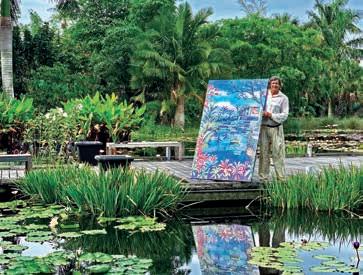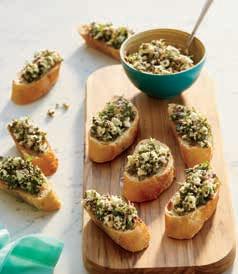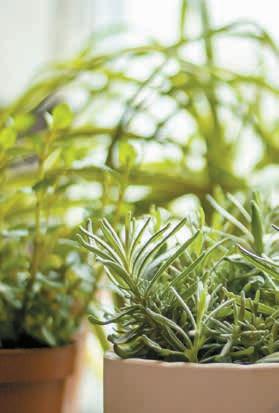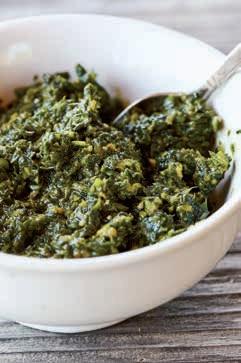
15 minute read
ARTIST PAUL ARSENAULT
Water Garden View, River of Grass, by Paul Arsenault
Artist Paul Arsenault Joins the Campaign for Clean Water
Advertisement
by Linda Sechrist
Quoting a Cheyenne proverb, “Our first teacher is our heart”, artist Paul Arsenault turns his eyes to look fondly upon his latest series of work, The Impressionist’s Garden: Plein Air Paintings, on display at the Naples Botanical Garden through November 8. A decade in the making, Arsenault’s heart and passion for the beauty of Southwest Florida’s natural environment are evident to the eyes of any beholder in the exhibit that celebrates not only the botanical garden’s evolution from a community dream to a worldclass establishment, but also the maturation of Arsenault’s artistry in transforming blank canvases into detailed, intricate colorful renderings dense with shapes, textures and shadows.
“The exhibit, with some of my never-before-seen works, shows my artful progression and my response to the lush landscape that amazed me when I moved to Naples from Massachusetts more than 40 years ago. My passion for botanical gardens has led me to trek the globe in order to paint many of them. The spark for painting contemporary life in coastal communities was ignited in my homeport of Hingham, known for its colonial history and location on Boston Harbor. My love for history and telling stories through my paintings enhances all of my work,” explains Arsenault.
Visible Stories
Arsenault’s deep connection to the ever-changing vistas of the 170-acre Naples Botanical Garden oasis, as well as his reputation for painting expressionist views of Florida’s other lush subtropical landscapes, led the garden staff to approach him last year with the idea of an exhibit. “Rather than offering my existing work, I imagined the assignment on a larger scale and decided to supplement my older works with 10 new six-by-four-foot canvases depicting various views of the five gardens. The collection of paintings represents my deep appreciation for our region’s distinctive ecosystems, as well as my process of living here and engaging with the community. They’re visible stories of how the gardens came about,” he says.
Rights of Nature
Arsenault’s deep love of the environment also set the stage for his collaboration with Joseph Bonasia, director of education for Lee County Rights of Nature (LeeRON), which is part of the Florida Rights of Nature Network, as well as the Rights of Nature worldwide movement to legally recognize the entitlement of ecosystems to exist, flourish and evolve naturally; the inalienable rights of human beings to clean air, clean water and healthy ecosystems; and the constitutional authority of local governments to declare and defend these rights.
“LeeRON is also about recognizing that our current regulatory system, highly subject to corporate influence and changing political systems, is failing us and Earth,” says John Cassani, a Calusa waterkeeper and member of the international Waterkeeper Alliance.
The Power of Art to Illuminate, Educate, Inspire and Motivate
Against the colorful backdrop of Arsenault’s art, Bonasia gave a LeeRON fundraising presentation at The Collaboratory, in Fort Myers. “I connected immediately with Paul’s vibrant art, which not only captures the essence of a place, but also beautifully and persuasively affirms what our hearts know better than our brains—that nature is infinitely more than mere property. Paul’s loving relationship with nature, visible on every canvas, evokes Paul Arsenault in viewers his same sense of nature’s intrinsic value beyond that of mere property, as well as a more intuitive understanding of nature.
“Paul resonated with our LeeRON efforts to assist and support citizens in amending their local city/county charter to create constitutionally framed environmental protections in their community. Paul and I had planned to do more coordinated presentations at his future shows, but COVID-19 temporarily changed that,” advises Bonasia. He is presently working with Chuck O’Neal, president of Florida Rights of Nature Network, Inc. (FRONN), to pass a Right to Clean Water charter amendment. Also known as the Wekiva River and Econlockhatchee River Bill of Rights (WEBOR), the proposed
Arsenault’s deep love of the environment led to collaborating with Joseph Bonasia, director of education for Lee County Rights of Nature, which is part of the Florida Rights of Nature Network, and Rights of Nature worldwide movement....
amendment to the Orange County Charter appears on the Orange County November ballot as Charter Question #1.
Home Rule Under Attack
FRONN is a grassroots collaboration of local initiatives across Florida, working in charter counties to protect nature’s rights, people’s rights to a healthy environment and home rule.
O’Neal notes that community self-governance is under attack. “Corporate interests help fund political campaigns and in return, get the laws they want. Increasingly these are state laws expressly meant to preempt local laws, gutting the powers of municipal governments and defying the will of the people. The game is rigged in favor of corporations and against citizens and the home rule powers of local governments. The failure of plastic bag and sunscreen bans in Coral Gables and Key West due to preemptive state laws are glaring examples,” advises O’Neal.
Failure of the Regulatory System
The current regulatory system regards nature as mere property, therefore anyone with a title to property has the legal right to harm it. “Human and natural communities who don’t have title to or a financial interest in the land lack legal standing to argue in court for protection. However, the individual or corporation that holds title of ownership does have standing. Their title or lease trumps the health, safety and welfare of the community, both human and natural. Granting legal rights to nature provides it and its human guardians the standing to defend the natural world in court. Rights provide the highest level of protection under law,” remarks O’Neal.
A Significant First for Florida and the Nation
In March, the Orange County Charter Review Commission voted to place the Wekiva River and Econlockhatchee River Bill of Rights on the county ballot. This is a first for Florida and the nation. Once approved by voters, this amendment will establish the right of these rivers to exist and be protected from pollution, as well as the right of residents to clean water.
“Nature has no means to defend itself from municipal and corporate economic actors that view themselves above nature. No longer can we afford to view nature as an endless resource to be exploited for human wants, profit and greed. RON lets “we, the people” become the voice for nature. RON laws are an expedient method to bring change to stop and reverse destructive impacts. It gives we, the people the legal right to bring the biggest polluters to task and hold them accountable,” advises Karl Deigert, LeeRON treasurer.
Visit Paul Arsenault’s paintings of the Naples Botanical Gardens on display at the Gardens through November.

The Importance of Wekiva and Econlockhatchee Rivers Bill of Rights
“While our entire state is dependent on its hydrology, all rivers in Orange County and 75 percent of our largest lakes are listed as impaired. Clean water in our lakes, rivers, canals, wetlands and Gulf of Mexico is vital to Florida’s tourism, its number one economic driver. We have reached a crucial point with polluted rivers and lakes suffering algae blooms, the over consumption of water and the destruction of wetlands. Now is the time for we, the people, to save our state from what appears be this new but unacceptable normal,” advises O’Neal.
This Right to Clean Water Charter Amendment is also crucial to Lee county because the Orange county’s southern point is the high point from which the polluted water flows south into the Kissimmee River Basin and into Lake Okeechobee. When the water level in Lake Okeechobee is too high, the U.S. Army Corp of Engineers opens the locks and releases the water which flows into the Caloosahatchee River and the St. Lucie canal.
“While the Clean Water Act maintains that the solution to pollution is diluting discharges, we believe it is to stop polluting. FRONN is in six Florida cities that are actively putting the Right to Clean Water amendment into play. When we are successful in Orange county with our ordinance, which does not violate Florida’s recently passed Senate Bill 712 increasing the signature threshold for citizen’s initiatives, we will be the template for any Florida municipality or city. Though there have been about three dozen cities and townships passing rights of nature ordinances, Orange will be the first county in the nation to do so,” enthuses O’Neal, who along with Bonasia, looks forward to realizing the impact of Arsenault’s art on the movement for clean water.
For more information, visit RightToCleanWater2020.com, Facebook.com/leeron2019, Fight4Zero.org/RightsOfNature and TheRightsOfNature.org.
Visit the Arsenault Studio at 1199 Third St. South, Naples. ArsenaultGallery.com See page 8.
SPICE UP HEALTH

markusspiske/Unsplash.com
Using Herbs for Flavor and Medicine
by April Thompson
Herbs add lush flavor to all kinds of dishes, and they are culinary friends that bring the benefits of helping to restore and maintain health. “Food is medicine, and herbs bring out the medicinal properties of food,” says Kami McBride, of Sebastopol, California, author of The Herbal Kitchen: Bring Lasting Health to You and Your Family with 50 Easy-to-Find Common Herbs and Over 250 Recipes. “The spice rack is a relic from another time when we knew how to use herbs and spices to optimize health and to digest our food.”
To get a medicinal dose of an herb, consider making teas, vinegar extracts or pestos, says Brittany Wood Nickerson, the Conway, Massachusetts, author of The Herbalist’s Kitchen: Delicious, Nourishing Food for Lifelong Health and Well-Being. “Parsley, for example, is a nutrient- and vitamin-rich herb. If you garnish with parsley, you won’t get a significant amount of vitamin C, as you would if you make a pesto from it.”
Salads can also pack a healthy dose of herbs into a meal, says Martha’s Vineyard resident Holly Bellebuono, an herbalist and author of The Healing Kitchen: Cooking with Nourishing Herbs for Health, Wellness, and Vitality. “So many herbs, including violets, mints and red clover, can just be tossed fresh into a salad, offering both fiber and minerals.”
Vinegars are one of Bellebuono’s go-to methods to incorporate herbs into a diet, infusing fresh or dried herbs into red wine or apple cider vinegar for salad dressings and other uses. “Vinegar is great at extracting minerals from herbs and making them more bioavailable,” she says.
Drying herbs does not diminish their medicinal properties, but rather concentrates their essence, as it removes excess water, according to Bellebuono. “Dried and powdered herbs are a great way to preserve the garden harvest and add herbs into everyday dishes. You can throw a teaspoon of turmeric, a wonderful anti-inflammatory herb, in spaghetti sauce or oatmeal, and you won’t even notice it,” she says.
Best Herbal Buddies
While Mediterranean herbs like oregano and basil are often at the front of the spice rack, Nickerson also suggests lesser-used herbs such as sour sumac, anise-accented tarragon and versatile, yet often discarded orange peels, which can be added to soups along with fennel seed and bay leaves for a complex flavor. Thyme is another of Nickerson’s favorites, a hearty herb for fall dishes that’s also a powerful antifungal and aids with digestion, lung health and detoxification.
While some may think of parsley as a garnish, “It offers incredible freshness and livens up almost anything,” says Nickerson. “I use it as a vegetable and make a salad of its leaves or add handfuls of it into a quiche. Parsley is loaded with vitamins and minerals, and has detoxification properties.” Adding it near the end of cooking maintains its vibrant flavor and color, she notes.
McBride loves versatile herbs like mint and coriander that can be used in sweet and savory dishes with antimicrobial properties that help fight colds and flu. She also keeps salt shakers on the table filled with spices like cardamom, an antibacterial, anti-spasmotic and expectorant, to sprinkle onto beverages and dishes. Bellebuono also recommends infusing honey with herbs such as sage or oregano that support the immune system.
Herbal-Aided Digestion
All herbs, whether leafy, green culinary herbs or spices like coriander and clove, are carminative, meaning they help digest food, McBride says. “Digestion can use up to 40 percent of your day’s energy, which is why you often get a nap attack after a big meal. Every meal needs a carminative, even if it’s just black pepper, which is one of the problems with most fast food.”
Pungent and bitter herbs, in particular, support digestion and absorption of nutrients and make them more bioavailable, says Nickerson: “Activating the taste buds dedicated to sensing bitter stimulates the digestive system.” A salad of bitter greens, for example, can help prepare digestion of a heavier meal to come, whereas a post-meal aperitif can help with digesting the food afterward.
“It absolutely adds up when you add small doses of herbs to your meals every day,” McBride advises. “Many Americans suffer from gastrointestinal inflammation from modern diets and lifestyles, and herbs can help reverse that. Your gut gets a little healing every day.”
April Thompson is a Washington, D.C., freelance writer. Connect at AprilWrites.com.
Spinach & Grapefruit Salad with Toasted Pumpkin Seeds

The floral notes of tarragon in the dressing and the juicy, sour grapefruit invigorate the senses and wake up the digestive processes.
Yields: 4 to 6 servings
8 oz spinach (about 4 packed cups) 1 large or 2 medium-size grapefruits ½ cup pumpkin seeds
Dressing
½ cup olive oil 1 Tbsp lemon juice 1 Tbsp white wine vinegar 1 tsp Dijon mustard 1 Tbsp finely minced shallot 1 tsp finely chopped tarragon Pinch of salt Tear the spinach into bite-size pieces, if necessary, and place in a large bowl. Cut the top and bottom off the grapefruit so that the flesh of the fruit is exposed so it sits flat on a cutting board. Cut the peel and pith from the fruit using a sharp knife or vegetable peeler. Set the grapefruit on one of its flat ends on a cutting board. The sections of the fruit will face up. Cut out the sections, slicing from the outside toward the center of the fruit, just inside the membranes. Leave the sections whole or cut them into bite-size pieces.
Toast the pumpkin seeds in a skillet over medium heat, stirring often, until they are lightly browned, have puffed up and begin to pop—4 to 7 minutes.
Combine the oil, lemon juice, vinegar, mustard, shallot, tarragon and salt in a bowl and whisk together. Stir in any grapefruit juice that may have puddled on the cutting board while sectioning the fruit.
Pour the dressing over the spinach. If any dressing is left over, it will keep in the fridge for up to a week. Toss the spinach well, then add the grapefruit and pumpkin seeds and toss gently again to combine.
Recipe and photo from Recipes from the Herbalist’s Kitchen by Brittany

bonniekittle/Unsplash.com

Wood Nickerson.
Mint and Feta Bruschetta with Chive Blossoms
Yields: 4 servings as an appetizer
½ cup fresh chive blossoms (can be substi- tuted with other edible flowers or left out) 1 French baguette ½ lb feta cheese, crumbled, or a vegan alternative 1 cup chopped fresh mint ½ cup minced chives (can be substituted with scallions) 2-4 Tbsp olive oil Salt and freshly ground black pepper
find clarity & perspective Clear out emotions that are no longer serving you.

Reiki | Psychic Readings Empowerment Workshops Meditation Coaching
in-person or remote session

by appointment only
Rita Davis M.Ed., Reiki Master Preheat the oven to 325° F. While the oven is heating, pull apart the chive blossoms, removing the central stem and plucking the tiny purple fl orets.
Set the baguette in the hot oven and bake for 7 to 10 minutes, until the edges are crispy, but not browned.

Meanwhile, combine the feta in a bowl with the mint, minced chives and chive fl orets. Add enough of the oil to moisten then season with salt and pepper to taste.

MARY JANE’S the ULTIMATE Skin Care, Certified Organic, Kosher, & Totally Vegan Hemp Seed Oil.




Mix well.
DRY “CREPEY” SKIN • • • • • • • • • WRINKLES • • • • • • • • • SOFTER SKIN • • • • • • • • • SMOOTHER LIPS • • • • • • • • • FACE • HANDS FEET • WHEREVER



For AMAZING DISCOUNTS Go to VolcanicOrigins.com or call 888-745-6806
Remove the baguette from the oven and slice along the diagonal. Arrange on a platter with 1 to 2 tablespoons of the bruschetta mixture on each slice. Drizzle with a little more oil and serve.
Note: For the bread to be crisp throughout rather than soft on the inside and crispy on the outside, slice it on the diagonal to start with, brush each piece with olive oil and bake on a baking sheet at 325° F for 5 to 7 minutes until crispy.
Recipe and photos from Recipes from the Herbalist’s Kitchen by Brittany Wood Nickerson.
Cilantro Pesto

Yields: about ½ cup
2 Tbsp (heaping) walnuts 2 cups packed cilantro leaves and stems (one large bunch) 2 garlic cloves 2 Tbsp olive oil Salt and freshly ground pepper
Soak the walnuts overnight in enough water to cover them. (Th is makes them easier to digest and helps remove some of the bitterness in the skin.)
Drain and rinse the walnuts. Combine them with the cilantro, garlic, oil and salt to taste, and a few grinds of pepper in a food processor. Blend until smooth.
Taste and adjust the seasonings as necessary. Th e pesto will keep for 5 to 7 days in the fridge or for 6 months or more in the freezer.
Recipe and photo from Recipes from the Herbalist’s Kitchen by Brittany Wood Nickerson.
Natural Awakenings recommends using organic, non-GMO (genetically modifi ed) and non-bromated ingredients whenever possible.




